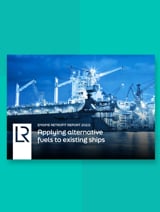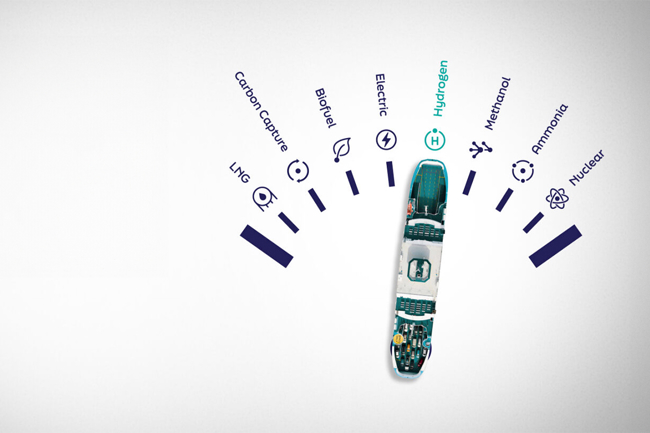Compare hydrogen readiness levels
The graphs below provide information on hydrogen fuels and their readiness levels. You can view the combined fuels and readiness levels or select them individually by clicking on the coloured labels and filters.
Exploring the advantages of hydrogen as a marine fuel
- Zero emissions: Hydrogen has the potential to be a zero-emission, well-to-wake fuel if produced using renewable energy (e-hydrogen).
- Light: Hydrogen has a very high specific energy density (approximately 33.33 kWh/kg) and is considerably lighter than other fuels when storing the same amount of energy.
Risks and disadvantages
- Storage requirements: Although hydrogen has a high energy density per unit weight, it has a low volumetric energy density and therefore poses storage challenges on-board as it requires either a significant amount of space or alternative storage methods, such as in liquid form in cryogenic tanks.
- Safety considerations: Hydrogen has unique safety considerations due to its flammability and potential for leaks, so stringent handling, storage and safety measures are crucial.
- Indirect GHG emissions: Whilst hydrogen is not considered a greenhouse gas emission in itself, if leaked into the atmosphere, it can react with other elements in the atmosphere to act as an indirect greenhouse gas emission. However, fuel cells are a closed energy system. Therefore, there should be no expected leaked hydrogen.
Differences between hydrogen fuels
| Blue hydrogen |
Blue hydrogen is produced from natural gas with carbon capture and storage (CCS). The hydrogen is separated from natural gas through steam methane reforming (SMR) or autothermal reforming. Carbon capture technologies are used to remove the CO2 generated through this process, and transport it for re-use or long-term storage. The hydrogen may then be compressed for transportation and storage.
|
| E-hydrogen |
E-hydrogen (also referred to as green hydrogen) is produced using renewable energy. Renewable energy is used to separate hydrogen from water through electrolysis. The hydrogen may then be compressed for transportation and storage. E-hydrogen is only a zero-emission fuel if the electricity used for electrolysis has zero carbon intensity; otherwise, there are different grades of 'green' depending on the carbon intensity of the electricity used.
|
Hydrogen readiness insights
Resources |
||||
| Fuel Type | Rating | Description | Justification | Challenge |
| Blue hydrogen | 5 | Testing prototype in user environment | Natural gas is readily available and currently used for this application, but carbon storage sites are limited | Exploration of new sites for storage and growth in re-use and recycling of carbon markets is needed. Additionally, effectiveness of long-term storage (lack of carbon leakage) needs to be proven. |
| E-hydrogen | 7 | Low scale pilot production demonstrated | Pilots have been demonstrated. Scale up required to meet shipping demands | A scaled up supply chain and workforce needs to be established for the supply of renewable electricity for the purpose of hydrogen generation for shipping. For this scale-up to take place, there will need to be demand signals from the market. |
Production |
||||
| Fuel Type | Rating | Description | Justification | Challenge |
| Blue hydrogen | 5 | Testing prototype in user environment | CCS has been validated in test environments in the context of the end-to-end production, however this validation has not been scaled up to reliably deliver the volume required to produce sufficient hydrogen fuel for commercial shipping. Steam methane reforming (SMR) and autothermal reforming (ATM) are established processes. | CCS facilities need to be industrialised at scale. Exploration of new sites for storage and growth in re-use and recycling of carbon markets is needed. |
| E-hydrogen | 5 | Testing prototype in user environment | Scaling of electrolysis process is now demonstrated in isolated projects. | Electrolysis facilities need to be industrialised at scale |
Bunkering and ports |
||||
| Fuel Type | Rating | Description | Justification | Challenge |
| Liquid | 5 | Testing prototype in user environment | Pilots have demonstrated technology capability in local environments | Bunkering of liquid hydrogen needs to be demonstrated in a range of different environments for scale up |
| Liquid organic | 5 | Testing prototype in user environment | Pilots have demonstrated technology capability in local environments | Bunkering of liquid organic hydrogen needs to be demonstrated in a range of different environments for scale up |
| Compressed gas | 5 | Testing prototype in user environment | Pilots have demonstrated technology capability in local environments | Bunkering of compressed gas hydrogen needs to be demonstrated in a range of different environments for scale up |
Ship - Onboard handling and storage |
||||
| Fuel Type | Rating | Description | Justification | Challenge |
| Liquid | 5 | Testing prototype in user environment | Pilot projects have been launched | Operation in a range of environments needs to be proven and relevant industry standards need to be developed. |
| Liquid organic | 5 | Testing prototype in user environment | Pilot projects have been launched | Operation in a range of environments needs to be proven and relevant industry standards need to be developed. |
| Compressed gas | 5 | Testing prototype in user environment | Pilot projects have been launched | Operation in a range of environments needs to be proven and relevant industry standards need to be developed. |
Ship - Propulsion |
||||
| Fuel Type | Rating | Description | Justification | Challenge |
| Combustion engine | 4 | Validation of integrated prototype in test environment | Prototype combustion engines have been developed at prototype stage, although there are no 100% hydrogen engines available yet | Engines that run on 100% hydrogen need to be developed |
| Fuel cells | 6 | Pre-production product | Fuel cells have been proven, however only on specific routes | Operation in a range of environments needs to be proven |
Resources |
||||
| Fuel Type | Rating | Description | Justification | Challenge |
| Blue hydrogen | 2 | Commercial trial, small scale | Storage has not reached the scale required to attract investment | Signals that show a stable, attractive market must be provided to investors. |
| E-hydrogen | 2 | Commercial trial, small scale | Small-scale commercial trials exist, but scale-up is still in the planning phase. | There is a need to reduce the risks of investing in countries with low credit ratings because many countries are well suited to provide renewable resources. |
Production |
||||
| Fuel Type | Rating | Description | Justification | Challenge |
| Blue hydrogen | 2 | Commercial trial, small scale | Storage has not reached the scale required to attract investment | Signals that show a stable, attractive market must be provided to investors. |
| E-hydrogen | 2 | Commercial trial, small scale | Small-scale commercial trials exist, but scale-up is still in the planning phase. | There is a need to reduce the risks of investing in countries with low credit ratings because many countries are well suited to provide renewable resources. |
Bunkering and ports |
||||
| Fuel Type | Rating | Description | Justification | Challenge |
| Blue hydrogen | 2 | Commercial trial, small scale | Commercial trials ongoing at a local small scale only | Strong demand signals for hydrogen as a fuel by shipping are needed to stimulate increased investment in development of port infrastructure for hydrogen bunkering in more geographical locations. |
| E-hydrogen | ||||
Ship |
||||
| Fuel Type | Rating | Description | Justification | Challenge |
| Blue hydrogen | 1 | Hypothetical commercial proposition | Trials are at prototype testing phase, with commercial use still at the planning stage. | There needs to be a clear financial model for competitiveness against fossil fuels. Additionally, technology readiness needs to increase for commercial trials to start. |
| E-hydrogen | ||||
Resources |
||||
| Fuel Type | Rating | Description | Justification | Challenge |
| Blue hydrogen | 2 | Stakeholder support or opposition is becoming understood as a result of pilots | Stakeholder concerns are understood as multiple unknowns around carbon storage, regulation and sustainability | Effectiveness of long-term storage (lack of carbon leakage) needs to be proven and communities need to be educated on the risks and benefits. |
| E-hydrogen | 4 | Evidence becoming wide-spread resulting in initial stakeholder acceptance | Small scale solutions show some acceptance at a local level. Growth to the required scale for the maritime industry is constrained by community concerns and lifecycle analysis | Communities need educating on the wider benefits of renewable energy and to dedicate land use for these purposes. |
Production |
||||
| Fuel Type | Rating | Description | Justification | Challenge |
| Blue hydrogen | 4 | Evidence becoming wide-spread resulting in initial stakeholder acceptance | CCS acceptance in some communities only as multiple unknowns remain around capture rates, effectiveness of long-term storage and sustainability | High capture rates and effectiveness of long-term storage (lack of carbon leakage) need to be proven |
| E-hydrogen | 5 | Increased transparency and formalised processes driving momentum for change | Small scale solutions show some acceptance at a local level. Growth to the required scale for the maritime industry is constrained by community concerns and lifecycle analysis | Communities need educating on the benefits of green hydrogen and to dedicate land use for renewable energy facilities. |
Bunkering and ports |
||||
| Fuel Type | Rating | Description | Justification | Challenge |
| Blue hydrogen | 1 | Stakeholder support or opposition is hypothetical | International standards for the bunkering of Hydrogen in a maritime context are yet to be developed. | Best practice needs to be evolved so that it can be formalised into an international standard. |
| E-hydrogen | ||||
Ship |
||||
| Fuel Type | Rating | Description | Justification | Challenge |
| Blue hydrogen | 1 | Stakeholder support or opposition is hypothetical | Safety risks not mitigated, safety and regulatory framework not in place | Policy needs to be stable and consistent across the value chain and globally. Note: combustion engines could cause indirect GHG emissions (methane) |
| E-hydrogen | ||||







